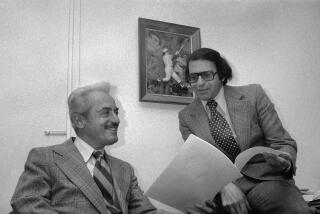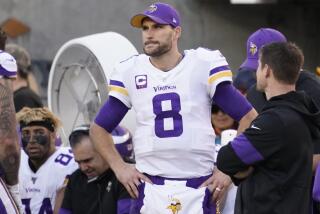Football War Ended With Merger 25 Years Ago
Jim Grabowski.
Not a name that jumps at you on the 25th anniversary of the NFL-AFL merger. Not like Joe Namath, Pete Rozelle, Al Davis, Tex Schramm, Lamar Hunt.
But Grabowski, a fullback from Illinois who was a hot prospect back in 1966, unwittingly set off the settlement talks that created one of America’s most valuable sports entities, the modern NFL.
They were the hottest days of one of sports’ hottest wars, 1965 and 1966.
A year before, the New York Jets had signed Joe Namath to a $400,000-a-year contract, a fortune in a sport where some annual salaries remained in four figures. The Jets had recently been purchased by Sonny Werblin (“Sonny, as in Money,” Howard Cosell would call him) and the league had a $10 million, 2-year contract from NBC that provided it with cash to chase other stars.
But that was the problem -- the war for players was leaving neither league very solvent and like today, veteran holdouts were the norm rather than the exception -- Ernie Ladd and Earl Faison, two of San Diego’s best players, were a cause celebre with a joint holdout during which they threatened to switch leagues.
“I can’t think of one team that made a profit,” Schramm says.
Friends became enemies -- Irv Kaze, an AFL public relations man was publicly snubbed when he went to greet two old friends from the NFL at Toots Shor’s, then New York’s favorite sports hangout.
Then along came Grabowski, who was the focal point of a less publicized but common war -- one between two NFL teams.
“We wanted him very badly,” recalls Schramm, who was in the process of turning the Dallas Cowboys from an expansion team to one that would miss the playoffs just once in the next 17 seasons. One reason: during the war, owner Clint Murchison opened his bank vault and allowed Schramm to spend as much as he needed to sign players from the other league.
“In those days, you would sign players before the draft, then make a show of taking them, even if you had a guy who was worth a fourth-round pick as your top pick.
“We were signing 95 percent of the guys we wanted, but Green Bay had more cash available and outbid us for Grabowski.
“I decided right there that we had to end this thing.”
There had been other talks among owners in the six years the AFL had been in existence. They all involved large groups on both sides and nothing ever came of them.
But this time, Schramm called Rozelle, the NFL’s commissioner, and told him, “let me try on my own.”
So Schramm called Lamar Hunt, whose Kansas City Chiefs were one of the AFL’s powers, and suggested one-on-one talks to end the war. Hunt lived a few blocks from Schramm in Dallas, although now he was in Kansas City, ready to head for an AFL owners’ meeting in Houston.
“I was cautiously optimistic,” Hunt says. “But these conversations had gone on informally for a number of years, even as early as 1960. I had no reason to think these were going to be any more productive than the ones before.”
One reason they hadn’t been productive was that the NFL wanted to merge in the AFL’s strong franchises, like Kansas City; fold weaker teams like Buffalo and Denver; move the Oakland Raiders to Portland, away from the San Francisco 49ers, and find the Jets a new home, where they wouldn’t compete with the Giants.
This time, Schramm’s plan would be more acceptable -- a complete merger with indemnity to the Giants and 49ers from the AFL.
He convinced Hunt to meet him in route to Houston. They met at Love Field in Dallas by the statue of the Texas Ranger and got into Schramm’s car, a 1966 Oldsmobile.
A few weeks later, they met in New York with Rozelle; Lou Spadia, owner of the 49ers and Wellington Mara of the Giants. But without Al Davis, who had just left the Raiders to succeed Joe Foss as the AFL commissioner. The combative Davis had an agenda of his own -- all-out war.
It almost happened.
Just as merger plans were being smoothed out, Mara and the Giants violated one of the unwritten rules, signing placekicker Pete Gogolak from Buffalo, the first established player to move from one league to the other. Davis had his war -- the AFL’s Houston Oilers signed quarterback John Brodie of the 49ers and tight end Mike Ditka of the Bears and the Raiders signed quarterback Roman Gabriel of the Rams.
“In early May, I told all the AFL owners that I had had discussion with Tex and thought there was a chance for peace,” Hunt recalls. “That’s when I told Al. There were a lot of doubters.”
Now Ralph Wilson of Buffalo and Billy Sullivan of New England were added to the merger talks. The NFL agreed to let the Raiders stay in Oakland and the Jets stay in New York; the AFL agreed to pay the NFL $18 million over 20 years, much of that money going to the Giants and 49ers.
There was still doubt. But Hunt believed, to the point that at one meeting, he called Sullivan and Wilson and put them on the phone with Schramm “just so they could hear Tex’s sincerity for themselves.”
Gradually, owners in both leagues came in. So did Rozelle, though Davis was wary -- if there was a merger, he hoped to become commissioner.
He didn’t, but he took care of his staff, which was still in the dark.
Val Pinchbeck, now the NFL’s vice-president for television, had been the sports information director at Syracuse, Davis’ alma mater.
When Davis took over, he convinced him to join the AFL staff as director of college relations. Kaze, who later worked for Davis with the Raiders in Los Angeles and Mickey Hershkowitz, a Houston sportswriter, also came on at the same time.
“Even now, I’m not sure when Al found out about the merger,” Pinchbeck recalls. “Then we heard one day there was a press conference at the Plaza Hotel, so Mickey and Irv and I went up there.”
The day was June 8, 1966. The press conference was about the merger.
“We went back to our office wondering if we had jobs. We found new two-year contracts on our desks,” Pinchbeck remembers. “Al wanted to take care of us.”
Pinchbeck ended up as the public relations director for the Denver Broncos, before coming back to the NFL office, where he now oversees an operation that nets each of the 28 teams an average of $27 million a year in television revenue.
It all started with that merger, which led to a common draft and a single championship game (renamed the Super Bowl three years later) in 1967 and a completely merged schedule in 1970. Now the Super Bowl is America’s single most-watched sporting event and NFL franchises are worth upwards of $150 million -- half the Giants were recently sold to Robert Tisch for $75 million.
The principals swear that greed wasn’t the motive.
“We just wanted peace,” Schramm says today. “We had no idea that it would become what it has become.”
On the other hand, nobody’s objecting.
More to Read
Go beyond the scoreboard
Get the latest on L.A.'s teams in the daily Sports Report newsletter.
You may occasionally receive promotional content from the Los Angeles Times.










